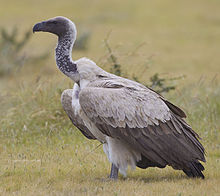White-backed vulture
| White-backed vulture | |
|---|---|
 |
|
| Adult in Etosha National Park, Namibia | |
| Scientific classification | |
| Kingdom: | Animalia |
| Phylum: | Chordata |
| Class: | Aves |
| Order: | Accipitriformes |
| Family: | Accipitridae |
| Genus: | Gyps |
| Species: | G. africanus |
| Binomial name | |
|
Gyps africanus Salvadori, 1865 |
|
The white-backed vulture (Gyps africanus) is an Old World vulture in the family Accipitridae, which also includes eagles, kites, buzzards and hawks. It is closely related to the European griffon vulture, G. fulvus. Sometimes it is called African white-backed vulture to distinguish it from the Oriental white-backed vulture — nowadays usually called white-rumped vulture — to which it was formerly believed to be closely related.
The white-backed vulture is a typical vulture, with only down feathers on the head and neck, very broad wings and short tail feathers. It has a white neck ruff. The adult’s whitish back contrasts with the otherwise dark plumage. Juveniles are largely dark. This is a medium-sized vulture; its body mass is 4.2 to 7.2 kilograms (9.3–15.9 lb), it is 78 to 98 cm (31 to 39 in) long and has a 1.96 to 2.25 m (6 to 7 ft) wingspan.
Like other vultures it is a scavenger, feeding mostly from carcasses of animals which it finds by soaring over savannah. It also takes scraps from human habitations. It often moves in flocks. It breeds in trees on the savannah of west and east Africa, laying one egg. The population is mostly resident.
As it is rarer than previously believed, its conservation status was reassessed from Least Concern to Near Threatened in the 2007 IUCN Red List. In 2012 it was further uplisted to Endangered. In October 2015, its status was changed to Critically Endangered because the ongoing decline is more severe than previously thought.
The population size of the white-backed vulture has been decreasing significantly within the past few decades. In 1922, the population was estimated at 270,000. Over the past two decades, its population has noticeably decreased. While not much is known about the current population, a recent study found that white-backed vultures have a high survival rate. Individual adults have the highest survival rate, while 2 year old birds have the lowest survival rate. Across all ages, the survival rate is estimated to be 90.7%. This means that the deaths of adult vultures will lead to rapid population declines. The loss of adults will cause less reproduction and with younger birds less likely to survive, the population will drop drastically. A major cause of population decrease is the loss of habitat. Elephants have been endangering the vultures, since they destroy the trees the vultures live and nest in. Vultures tend not to nest in areas with high elephant populations.Fires have also caused the destruction of trees. Humans also have a large impact. Our power lines have caused many vultures to be electrocuted. In Kenya especially, humans are using a very toxic pesticide called Furadan, which has led to many vulture deaths. Vultures are also being poisoned by humans, although not intentionally. In order to kill hyenas, lions, and other predators, herders add poisons into their livestock. Vultures ingest the poison upon eating a deceased animal's carcass. This poisoning generally occurs outside of protected areas, but is a leading factor in the population’s decline. Habitats are being also disturbed by human land management and direct nesting persecution patterns.
...
Wikipedia

